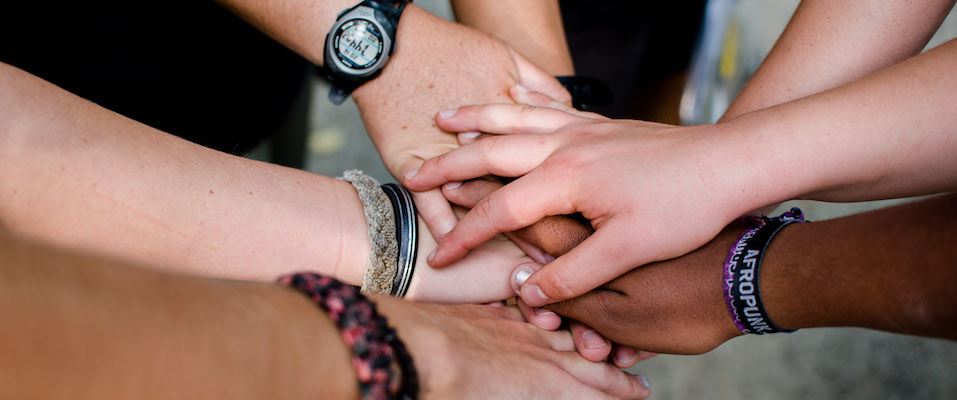This spring, a handful of college kids were in a basement classroom of Barrows Hall gathered round an overhead projector. On the screen, there was a meme: a photo of a half-naked model with super-imposed text that read, “Real women have curves.” One of the students scoffed and said, “She doesn’t.” Everyone laughed. At about 5’7” and weighing in at roughly 110 pounds, she really didn’t. And noticing things like that was the point of why everyone showed up—to talk about body image.
The meeting was held by Body Peace, a UC Berkeley student-run support group for eating disorders and body image issues that was founded in 2012 by Cal grads Kim Russo and Kristen Lee. While attending Berkeley, the women noticed there weren’t feminist or women’s empowerment groups on campus at the undergraduate level regarding body-image or self-esteem, and felt that needed to be corrected. Lee handled marketing, recruiting, and networking while Russo got a constitution drafted and earned support from the university health center.
“Berkeley has all of the signs of a place where it would be really easy for women to be sucked into eating disorders because it’s very competitive,” says Russo, who suffered from anorexia in her teens. “There’s a lot of self-criticism—a perfect setting for an eating disorder to blossom.”
Just this spring, a Berkeley-specific, National College Health Assessment survey revealed that roughly 5.8 percent of undergrad and graduate students experience problems related to eating disorders, with 2 percent revealing that the disorders have affected their academic performance—be that receiving lower grades on exams or dropping courses completely. And in recent years, there’s been an uptick in students seeking help at the university.
“We have definitely seen an increase in the number of [eating disorder] patients,” says Toby Morris, clinical dietician at Berkeley’s University Health Services. She says it’s hard to know why that is, though. “I doubt that there’s more students overall with eating disorders. I’m hoping that it’s just that the word is out that we have this service.”

It’s also difficult to pinpoint just how many students on campus are struggling overall, Morris says, because most people don’t admit they have disorders. In an effort to get a clearer picture, when Morris gives lectures on campus, she’ll often have the audience participate in an anonymous quiz to gauge their relationship with food—asking if they’ve engaged in one or more disordered eating behaviors within the last six months.
“Whether or not they meet the criteria for a full-blown eating disorder—the vast majority of people are engaging in really disordered behaviors,” Morris says. “Like purging, or smoking cigarettes as a way to lose weight, fasting or going a day or more to control weight, extreme eating and exercise behaviors, etc.”
What muddies the waters of diagnosing disorders is that many students have what’s called EDNOS: eating disorders not otherwise specified. This means they’re exhibiting a combination of behaviors that don’t precisely match the specific, “classic” disorders like anorexia or bulimia, and consequently EDNOS can be more complicated to treat.
The body problem that is most pervasive and worrisome, Morris says, is body dissatisfaction—the number one determinant of developing an eating disorder. Morris says the stress of attending a top public university combined with body dissatisfaction is a recipe for an eating disorder.
Benudiz says the transition to college was particularly stressful to her because she didn’t have any friends at Berkeley, and she “knew for a fact that it would trigger old habits and old negative self-talk.”
“Berkeley is a competitive environment, for sure. And these students that get in are already high-achieving, goal-oriented young people,” Morris says. “The characteristics that make you a really good student in this competitive environment might also be elements that predispose you to having an eating disorder.”
And that’s where Body Peace comes in, according to the group’s president Aliyah Benudiz, a public health major and food systems minor. Body Peace can act as a kind of informal therapy, she says—a preventative measure against developing full-blown disorders.
“The resources that are available [at UC Berkeley] are very sparse,” says Benudiz, who came to Berkeley right after getting out of treatment for disordered eating when she was in high school. “And they only serve a small community of people who are actively suffering with an eating disorder or are actively sick, versus people who just need to talk about their problems before it gets to that point.”
Benudiz says the transition to college was particularly stressful to her because she didn’t have any friends at Berkeley, and she “knew for a fact that it would trigger old habits and old negative self-talk.”
“It very intimidating to me. I foresaw what could happen—my mental health deteriorating,” Benudiz says. “And I wanted to prevent that right off the bat.”
Benudiz’s fear of slipping back into disordered eating in her college years isn’t without foundation. If you look at the statistics—15 percent of college-aged women 17-24 have eating disorders, according to the Multi-Service Eating Disorders Association (MEDA); 20 percent admit to having had an eating disorder at some point in their lives and 91 percent of female college students admit to trying to control their weight through dieting.
The data on college-aged men is a little more sparse—possibly because assessment tests are directed at women, not men. According to the National Eating Disorders Association (NEDA), men may be less likely to come forward because they fear stigma more than women. In 2005, a study of a large university campus revealed that 3.6 percent of men had “positive screens” for eating disorders, meaning their symptoms or behaviors indicated the presence of a disorder. When compared to women on campus, though, the ratio was 3–1, with 13.5 percent of women yielding positive screens in comparison.

Body Peace’s attendance reflects these statistics; despite being open to all genders and orientations, attendees are primarily female.
“We’ve had male members before … [eating disorders] affect everybody because men also have high expectations for what their bodies should look like or what they should be doing for their bodies,” Benudiz says. “Especially around the culture of working out and lifting…. So it’s important to establish a community for them as well.”
“Unfortunately, eating disorders—or even more broadly, body image issues—can get labeled as a ‘women’s issue,’ but everybody has a body image,” says psych major and Body Peace vice president Julia Kulewicz. “While I think the numbers might actually be higher for women … there’s still a lot of research that needs to be done for males and people who are non-binary; there’s so many more areas of research to be conducted.”
Body Peace meets every Wednesday night during the school year to arrange their desks in a circle and and share concerns, thoughts, and tribulations related to body image.
They start by going around the room for “check-ins,” allowing each student to air their ideas with “no judgment, no pressure.” And then they put the group’s guidelines on a PowerPoint slide, reminding everyone that all things said in the room are confidential and that there should be “no mentioning of specific numbers or harmful behaviors.” The “numbers rule” exists, according to Russo, because people are already in a competitive mindset about their bodies; if someone mentions a specific weight, track and field time, bra size, or whatever, that can activate a person’s desire to compare herself to others, which can be defeating.
At Berkeley specifically, Morris says, the pressure around food consumption goes beyond the age-old “I wish I were thinner or fitter” mentality associated with eating disorders—and extends to subjects like food science, justice and morality.
Benudiz and Kulewicz come up with different subjects to cover at each meeting and a range of activities. They might do yoga or listen to an educational presentation on body image and feminism in the media, or they may engage in a crafts project to make heart-shaped stickers with inspirational messages to post around campus. Their goal is to get different kinds of discussions going to de-stigmatize eating disorders and give people a safe space to admit they have a problem, says Kulewicz, while also creating coping strategies to get through body dissatisfaction.
“We also try to in general help people overcome anxieties and depression and to not take their feelings out on their body,” Russo says. She cites as an example, the student who uses restrictive eating to gain a sense of control in her life. “At Body Peace, we would examine what the root cause of the feeling of lack of control might be and what other healthier ways the student can take control.”
The group embraces “body positivity,” a term criticized recently for the emotional pressure and impossible expectation it can put on women to always “love” their bodies. Which is not to suggest, Russo says that the aim of the group is to “turn society’s body ideals upside down by, for instance, embracing our fat rolls or acne.” Rather: “At Body Peace, we aimed to step back from ideas about how our bodies should look, and instead see our bodies as functional and sensual, not just visually appealing.”
At Berkeley specifically, Morris says, the pressure around food consumption goes beyond the age-old “I wish I were thinner or fitter” mentality associated with eating disorders—and extends to subjects like food science, justice and morality.
“At Berkeley, we have this superfood culture, there’s a lot of stuff here around food justice and environmentalism—and I think sometimes that adds to the mix [of stress], and then people develop anxiety around food that they didn’t have before,” Morris says.
The university founded its own food research center, the Berkeley Food Institute, in 2013 to address the changing “dialogue” about food—and to transform campus food systems to become more “diverse,” “resilient,” “healthy,” and “just.” In the year of its opening, the institute’s executive director L. Ann Thrupp said, “The academic community is recognizing that when it comes to food, it’s no longer possible to tease out agriculture from environmental, public policy, social justice and public health issues.”
Because of the intellectual and social justice conversation around food, it may be hard for students to reconcile their eating habits with the stream of food info they’re ingesting, Morris says. Studies show that labeling food as “good,” “bad,” “healthy,” “unhealthy,” “immoral,” “moral,” and so on, can create “food guilt” that affects not only what food you choose to eat but whether you choose to eat anything. When you’re pulling an all-nighter studying and you realize everything else is closed, it’s not like you can order a “diverse, resilient, healthy and just” Domino’s pizza—and if you do order it, do you share it with a fellow hungry student?

The Berkeley Student Food Collective was founded in 2010 as a volunteer-run, nonprofit grocery that served “fresh, local, healthy, environmentally sustainable, and ethically produced” food. In a Daily Cal op-ed from 2014, the collective’s previous communications director Matthew Kirschenbaum criticized UC Berkeley for turning food access from a right into a privilege by “jacking up” prices at Cal’s on-campus dining facilities, to make the highest profit. With a seeming air of distaste, Kirschenbaum added, “Cal Dining’s private control over food access is called capitalism.”
Today, the Collective partners with both Cal Dining and University Health Services to address food access from a holistic perspective. “We distribute student-grown produce from Cal Dining’s gardens, sell student-cooked meals on a Pay-As-You-Can basis, and regularly deliberate over the quality and accessibility of the food we provide,” said Jeff Noven, the Collective’s current Executive Director. “Student choice and student support are the foundation of our organization.”
“There were some students who were totally normal about food before they came here and then they developed eating disorders,” Morris says. “Of course—I think it’s complex, it’s not that simple. But sometimes the food culture here can do people more harm than good, I think.”
While University Health Services provides care for students with eating disorders, Morris says their treatment is best suited to people who are highly motivated, medically stable and making gains in decreasing their behaviors. If the problem is more serious, students are referred to outpatient resources for intensive care.
“I love that Body Peace exists,” says Morris. “Changing that paradigm to prevent the development of eating disorders is so important. Because even though I’m in this eating disorder clinic and I’m working on treating the actual eating disorders—I know that working more upstream on changing the culture of the campus and changing how we address body image can help to prevent the eating disorders.”






















